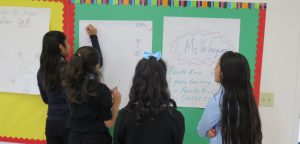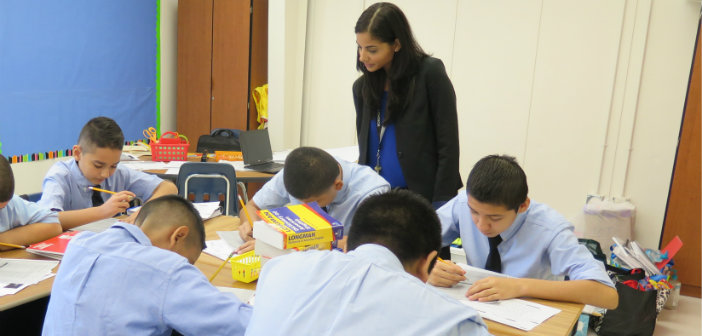 On the first day of the new school year, Alex Sanger Elementary School welcomed a new class of 60 smiling and eager sixth-graders.
On the first day of the new school year, Alex Sanger Elementary School welcomed a new class of 60 smiling and eager sixth-graders.
El primer día de clases, la escuela Alex Sanger le dió la bienvenida a 60 alumnos del sexto grado sonrientes y ávidos por aprender.
Sanger’s new sixth-graders likely understand both those sentences because they are enrolled in a dual language program that features instruction in Spanish and English. Sanger, located near White Rock Lake, this year expanded its dual language program through sixth-grade. Previously, the school only went up to fifth-grade.
Elsy Serpas, a sixth-grade math teacher at Sanger, said parents were the catalyst for expanding the dual language program.
“The idea came from the PTA, the site-based decision-making committee and the dual-language parent advisory group,” she said.
When the district began expanding its School Choice initiative, which aims to provide students with a high quality, best-fit school, Sanger parents asked administrators to extend the dual language program to middle school. Next year, the school will add seventh-grade. Sanger Principal Hector Martinez said many families are attracted to the opportunity for students to learn in two languages starting in preK, however they can also opt for English-only instruction.
While Sanger’s sixth-graders are fully capable of excelling in English-only classes, Serpas said the school’s philosophy is to create students who are bilingual, bicultural and biliterate, which means they’re prepared to perform academically in two languages and across cultures. Sanger’s curriculum mirrors that of most middle schools except that students receive instruction in two languages. Serpas will teach math in English. Reading/language arts teacher Jarriza Velazquez will teach 50 percent of the time in English and 50 percent in Spanish, and science instruction will also be in Spanish.
Across Dallas ISD, an estimated 3,000 students are enrolled in dual language programs in 32 elementary schools, four middle schools and one high school, Sunset, where the program was implemented just this year. Administrators say the demand is growing. As students become bilingual in elementary school, parents are asking for the creation of programs in the upper grades.
Parents and educators say the benefits of a bilingual education include: Spanish-speakers retain and get stronger in their native language. Students learn to speak and reason in two languages and enter high school having already earned their foreign language credit.
More importantly, Serpas said students who graduate fully bilingual are able to more successfully compete in college or the workforce.
“In this country and in the world, it’s almost becoming necessary to be bilingual,” Serpas said. “If we don’t start teaching our children now, it will be much harder to compete with the world.”

